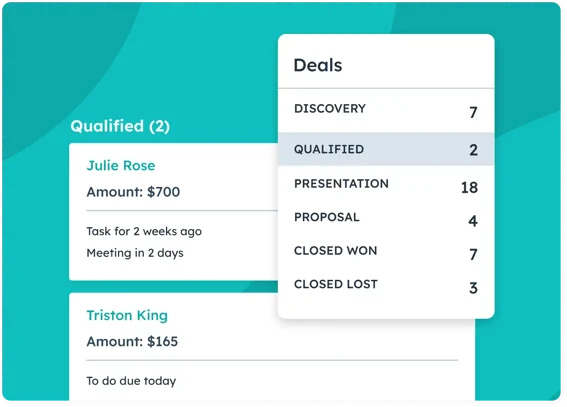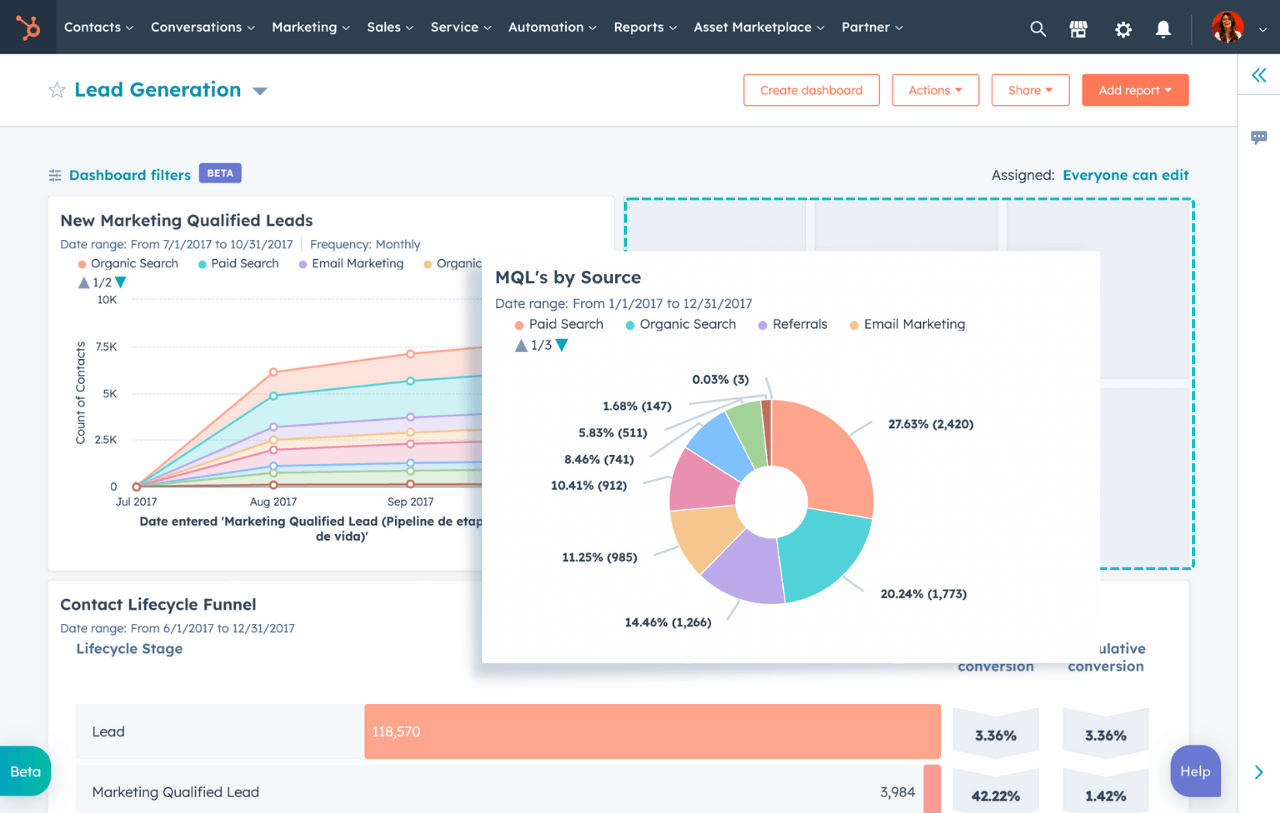HubSpot Sales Hub is an integrated platform ...

Website Redesign: How to Plan, Execute, and Succeed
2 Jun 2025
Table of contents
Your website is no longer generating the results you expect. Three major signals indicate that it's time to act: declining performance, an obsolete design or a brand image that has evolved.
When your home page takes 10 seconds to load, your contact form no longer works or your site looks like it did 10 years ago, your visitors are going to the competition. And that's normal!
Redesigning your site is an opportunity to correct all these problems at once: improve your SEO, modernize your design and optimize the user experience to convert more prospects into customers.
In this article, our marketing experts explain how to identify the signals that justify redesigning your website, and how to plan your project step by step.
What is a website redesign?
A website redesign involves modifying your existing website to make it better and more efficient. A partial redesign is when you modify only a specific aspect of your site, while a total redesign is when you completely transform your online presence. Here are different types of web redesign.
Partial redesign :
- Graphic redesign: modernization of design, ergonomics and mobile adaptation
- Technical overhaul: migration to a new CMS, improved performance and security
- Structural overhaul: rethinking tree structure, content and strategy
Total redesign :
- Complete overhaul: total transformation combining design, technique and structure for a complete reset of your online presence.
When should you redesign your website?
Here are a few reasons why it's time to redesign your website.
1. Loss of performance or traffic
Your site is losing positions in search results, and your organic traffic is declining. This often means that your site no longer meets the criteria of Google and other search engines.
Outdated architecture, poorly optimized or obsolete content, and technical problems can explain this drop in visibility. A redesign can help you get back on solid SEO footing and regain your positions.
That's what happened to one of our customers, who called on our services in the face of steadily declining traffic.
Discover CERC's SEO and marketing case study
2. Falling conversion rates
Your company's website attracts visitors. But they're not taking action. This poor performance often reveals a number of problems: complex navigation, inconspicuous calls to action or lack of trust.
This situation can generally be explained by several factors:
- an excessively long ordering tunnel
- Poorly designed forms
- Lack of reassurance (testimonials, trustmarks)
- Unconvincing product pages
- General usability problems
To solve these problems, a website redesign focused on increasing conversions allows you to improve navigation, calls to action and page structure.
3. Outdated design or poor user experience
If your site hasn't moved in 4 years, your audience and Google may find it outdated. An outdated design damages your credibility and drives your prospects to the competition. Your potential customers trust a modern, professional site more than one that looks abandoned.
Poor user experience can be seen in a number of ways:
- Confusing or unintuitive navigation
- Excessive loading time
- Hard-to-read content
- Unclear buttons and links
- Lack of clear visual hierarchy
4. Site not mobile-friendly or too slow
More than half of all web traffic now comes from mobile devices. If your site doesn't display properly on a smartphone, or takes longer than 3 seconds to load, you're losing a significant proportion of your visitors. According to Google Consumer Insights, 53% of mobile users leave a page after 3 seconds.
The most frequent mobile compatibility problems :
- Text too small to read easily
- Buttons and links too close together or difficult to click
- Non-responsive interface requiring zooming
- Horizontal navigation required
- Pop-ups that obstruct content
5. New strategic or functional needs
Your business is changing, but your website isn't always keeping pace. This often happens when you launch new services, adjust your positioning or target a different clientele. In such cases, your site no longer truly reflects what you offer, and can even hinder your development.
Company mergers also create this need. Two entities join forces? Their digital identities need to converge. The new website must reflect the shared vision, while retaining the strengths of the original brands.
When your site no longer matches your objectives, you miss out on opportunities. Your prospects have trouble finding what they're looking for. At the same time, your sales teams struggle to qualify incoming contacts.
6. Conclusion: should you redesign your site?
| Indicator | Warning threshold | Recommended action |
| Site age | Over 3-4 years without major update | Complete transformation |
| Organic traffic | Decline of more than 20% over 6 months | SEO audit then restructuring |
| Conversion rate | Below 2% or constantly falling | UX/UI optimization |
| Loading time | More than 3 seconds | Technical improvements |
| Mobile compatibility | Non-responsive site | Urgent adaptation |
| Bounce rate | Over 70% bounce rate | Ergonomic revision |
| Security | No SSL certificate | Immediate updates |
| Obsolete CMS | Version not supported | Technical migration |
| Business evolution | New services or positioning | Strategic restructuring |
| Competition | More modern competitor sites | Competitive modernization |
Essential steps in a website redesign
Successfully redesigning your website to generate qualified leads requires you to follow certain key steps. Whether you call in the experts or manage the change yourself, these steps are essential.
Here's our method for transforming your site into a high-performance tool.

1. Complete audit of current site
We analyze your existing website from every angle: response times, technical errors, SEO positions and user paths. This phase enables us to identify exactly what's holding back your conversions and visibility. The audit reveals opportunities for improvement and content to be preserved.
2. Definition of objectives and strategy
Together, we set realistic, quantified objectives for your web redesign. By analyzing your personas and your market, our team develops a suitable editorial line and SEO positioning. This roadmap guides all our decisions during the project.
3. UX/UI design and structure of the future site
Our designers create theoptimized tree structure and mock-ups of your strategic pages (usually in Figma). Before development, we test navigation and ergonomics to ensure a fluid UX.
Working with a local website agencyallows us to tailor ergonomics and navigation even more closely to the expectations of your target customers.
4. Development and integration
Time for action! Our developers transform the mock-ups into a functional site on the CMS best suited to your needs, whether you want to migrate to HubSpot or Webflow. At the same time, we integrate your content, optimizing it for natural search engine optimization.
5. Tests, adjustments and launch
We test every feature on all devices and browsers. Before going live, we configure the analysis tools to monitor the various KPIs.
6. Post-launch monitoring
We monitor your site's performance and intervene quickly if any problems arise. During the first few months, we optimize any elements that are underperforming.
Our services for redesigning your website as a web marketing agency
As a HubSpot-certified web marketing agency, we help companies redesign their websites. Our goal? To bring you more customers.
Audit: We analyze the problems with your current site and define how to attract more prospects to your sector.
UX/UI design: Our web design service creates pages where your visitors can easily find what they're looking for, and contact you more often.
Technical development: We migrate your site to HubSpot or Webflow and connect your tools so you can easily track your leads.
B2B SEO optimization: Our agency works on your SEO so that your potential customers find you when they search for your services on Google.
Video production: A video shows what words sometimes leave out. Your team at work, your customers recounting their experiences. It's real. It builds confidence.
Beyond the image, video improves your performance. Search engines value sites that offer video. A video format attracts attention, reduces bounce rates and lengthens visit duration.
Another key point is that video is easy to share on social networks. It attracts, engages and drives traffic back to your site. To find out more, discover our video production agency in Montreal.
Frequently asked questions about website redesign
What is a website redesign?
A redesign is an in-depth reworking of an existing website to improve its appearance, structure, performance and functionality.
What are the challenges of a website redesign?
The main issues are :
- Preserving your SERP ranking: maintaining your Google positions through 301 redirects and SEO optimization
- Improving conversions: Optimizing the sales tunnel and user experience to increase sales
- Technical performance: Ensure mobile compatibility, reduce loading times and improve security
- Measuring results: Implement effective tracking to analyze performance
Why redesign your company's website?
- Obsolete site (more than 3-4 years without updates)
- Decline in organic traffic or conversions
- Non-responsive design or slow loading times
- Evolution of your business (new services, company merger)
- Need for new functionalities (e-commerce, customer area)
What are the different types of redesign?
- Partial redesign: modification of specific elements of the site
- Total redesign: complete redesign of the site, including design, structure and functionality.
Why use a web marketing agency for your website redesign?
Redesigning a website isn't just about technical development. It requires a combination of design, UX, SEO and marketing strategy, all mastered by experts. While they're working on your website, you can stay focused on your core business without worrying about the technical aspects.






